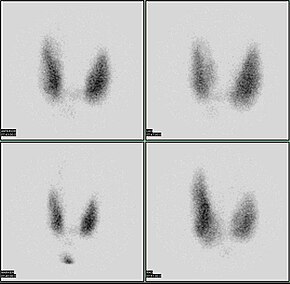Radioactive iodine uptake test
| Radioactive iodine uptake test | |
|---|---|
 Thyroid scan with Iodine-123 for evaluation of hyperthyroidism. | |
| Synonyms | RAIU test |
| ICD-9-CM | 92.01 |
| OPS-301 code | 3-701 |
The radioactive iodine uptake test is a type of scan used in the diagnosis of thyroid problems, particularly hyperthyroidism. It is entirely different from radioactive iodine therapy (RAI therapy), which uses much higher doses to destroy cancerous cells. The RAIU test is also used as a follow-up to RAI therapy to verify that no thyroid cells survived, which could still be cancerous.[1]
The patient swallows
The normal uptake is between 15 and 25 percent, but this may be forced down if, in the meantime, the patient has eaten foods high in iodine, such as dairy products and seafood.[4] Low uptake suggests thyroiditis, high uptake suggests Graves' disease,[5] and unevenness in uptake suggests the presence of a nodule.[citation needed]
123I has a shorter
Contraindications
The test is inappropriate for patients who are pregnant or breastfeeding.[5]
Additional images
-
Thyroid scintigraphy
LMP BNUKSEA 4000+60000
References
- ^ [1] ThyCa: Thyroid Cancer Survivors' Association, Inc., Radioactive Iodine (RAI).
- )
- PMID 29165912.
- ^ M. Sara Rosenthal. The Thyroid Sourcebook. McGraw-Hill, 2008. Page 140.
- ^ a b WebMD article on RAIU test.
- ISBN 978-0-07-174348-8. Retrieved 18 July 2011.
- ISBN 978-0-435-63098-0. Retrieved 18 July 2011.

